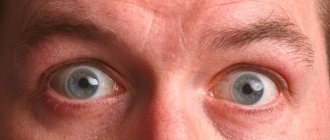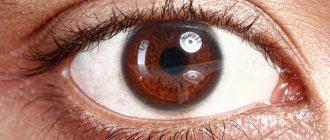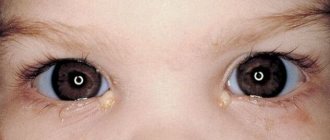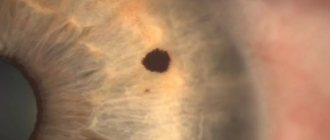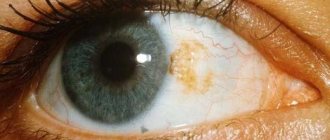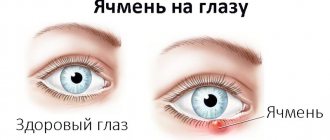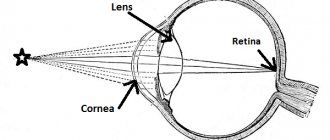Causes of broken capillaries in the eyes
Below we will present and consider in detail the most common causes of ruptured capillaries in the eyes.
Arterial hypertension
The main reason why blood vessels burst is high blood pressure. Most often this occurs in those who have hypertension complicated by a hypertensive crisis. The brain, liver, heart and eyes are most affected by this disease.
What is a hypertensive crisis? It is a sudden increase in blood pressure to extremely high numbers, determined for each individual. That is, for some it can begin already at a pressure of 140/90 millimeters of mercury, while for others only at 200/100 millimeters of mercury. In this case, the vessels located inside the eyeball lose their elasticity and rupture, as they cannot cope with the increased blood flow.
Great physical activity
If you engage in active physical labor for a long time, there is a high probability of vascular rupture. During heavy lifting or active sports, blood pressure rises, which, as in the case of hypertension, causes capillaries to burst.
Eyeball injuries
The reason for the appearance of burst vessels may be a bruise or blow to the eyeball. Hemorrhage is also common in cases of clinical intervention, such as lens replacement surgery.
Diabetes
This disease is characterized not only by a deficiency of insulin in the blood and an increase in glucose, but also by damage to capillary vessels. This can be explained by the fact that an excess of glucose has a negative effect on the walls of blood vessels, as a result of which they become thinner in some areas and thicken in other areas. This process leads to a decrease in the elasticity of blood vessels, which also affects their strength.
Eye fatigue
Eye fatigue has become a common disease for every office worker. Increased pressure on the eyes is observed in those who spend a lot of time at the computer or reading, especially texts in small print. Also, poor lighting and long hours of work without rest breaks can lead to rupture of capillaries (important for students during the exam session), since the eyes are constantly under tension, there is a constant flow of blood to the eyeballs, which leads to rupture of the capillaries.
Sudden change in weather conditions
Those people who can be classified as weather-dependent often suffer from ruptured capillaries in the eyes. This is due to a sharp increase or decrease in blood pressure.
Inflammation of the cornea
Inflammatory processes in the eyes often lead to redness. Inflammation can be triggered by mechanical trauma to the retina, allergies, mechanical or thermal burns, or foreign bodies entering the eye. Also, the cause of inflammation of the cornea can be a disregard for eye hygiene. Symptoms of this disease, in addition to rupture of capillaries, are lacrimation and intolerance to bright light.
Read: Hemorrhage under the conjunctiva is called subconjunctival hemorrhage.
Conjunctivitis
The reasons for the appearance of this disease are the same as for inflammatory processes in the cornea. Often they occur simultaneously. Symptoms include itching, burning, discharge from the palpebral fissure, and rupture of blood vessels.
Neoplasms of the eyeball
The appearance of a tumor on the eyeball will invariably lead to deformation of the blood vessels of the eye, making them susceptible to rupture.
Lack of vitamins in the diet
If you do not consume enough vitamins C and P, this can cause the vascular wall to thin, so that it becomes easily vulnerable and bursts.
Fragility of vascular walls
The condition of blood vessels is affected by medications and eye diseases, which can cause increased fragility of blood vessels.
Head injuries
In the case of traumatic brain injuries, there is often a disruption in the blood circulation in the brain and the outflow of cerebrospinal fluid, which can cause an increase in blood pressure in the vessels of the eyes.
Overheat
If you like to visit a bathhouse or sauna, then burst capillaries may be a sign that you have stayed there too long. If this happens rarely, you have nothing to worry about. However, if you experience regular symptoms, you need to stop going to these places and immediately consult a doctor.
Also, rupture of the vessel can be caused by sunstroke or being in a room with too high a temperature.
Improper wearing of contact lenses
Many of those who use contact lenses neglect their care. To prevent eye bleeding, change your lenses regularly, remove them at night, and do not leave them on if you feel discomfort. Rubbing the eyeball not only contributes to the appearance of burst blood vessels, but also the development of a number of eye diseases.
Alcohol and drugs
Excessive alcohol and drug use leads to a sharp increase in blood pressure, which causes burst capillaries.
Poor quality mascara or eye shadow
Bad cosmetics can cause hemorrhage. Always check the expiration dates of cosmetic products, and also, if you have sensitive eyes, buy only those mascara and shadows that have been approved by ophthalmologists.
Tears
While sobbing, a person involuntarily begins to rub his eyes, which leads to damage to the capillaries. Tears, which contain salt, irritate the damaged areas even more, so a person instantly becomes inflamed.
Related Issues
Hemorrhages are dangerous for vision!
A rupture of a vessel on the surface of the eye does not affect a person's vision in any way, but hemorrhage inside the eye can lead to a serious decrease in vision. And if it happens, then the person needs to be examined by a doctor and treated for the identified diseases that cause such disorders.
Broken capillary under the eye
There are also similar cases when a person in the morning, looking at himself in the mirror, suddenly discovers a hematoma under his eye. It looks like this person was hit in the eye area during a fight. Many people with such appearance are ashamed to even go out into the street. If it’s just a red eye, then at least it’s clear why it happened, but a black eye under the eye doesn’t look good on anyone.
If a hematoma appears under the eye, you need to check whether it is an insect bite. After all, the area under the eyes is very delicate and such a bite can cause serious swelling and hemorrhage. If there is no bite, then the person should be checked by a doctor for the possibility of developing hypertension, because such hemorrhages usually appear due to high blood pressure.
Hematoma on the eyelid
The same can be said about a case in which a vessel on the eyelid burst and a hematoma occurred. Most likely, these are the consequences of high blood pressure. In addition to combating pressure, you can use absorbable ointments to quickly disappear the hematoma.
Symptoms
This pathology has one pronounced sign - a reddened eye with a bloody spot on it. It can be very small and barely noticeable if only one capillary has burst, or it can cover the entire front part of the eyeball if there are several vessels that have burst. It is worth noting that redness can only be observed if the torn vessel is located on the front visible part of the eye, but it can also be located behind. In this case, you will feel a slight heaviness in your eyes.
What are the types of hemorrhages in the eye?
Experts divide hemorrhages in the eyes into several categories, depending on their location. Next we will look at each type in detail.
Retinal capillary rupture
This type of hemorrhage can lead to complete loss of vision. The retina, which is part of the eyeball, contains receptors through which visual perception occurs. That is why a burst capillary disables some important receptors. Patients who experience this type of hemorrhage may complain of the appearance of floaters and blind spots, as well as sharply decreased clarity of vision.
Rupture of orbital vessels
With this type of hemorrhage, blood cells penetrate into the fat cell, which is located behind the eyeball. Symptoms of this pathology include swelling, bruising under the eye, protrusion of the eyeball from the socket, pain during movement of the eyeball.
Rupture of blood vessels in the vitreous body
Thanks to the vitreous body, light rays pass through and hit the retina. In case of hemorrhage, the transparency (transparency) of the vitreous body is impaired, which manifests itself in the form of a sharp drop in the quality of vision.
Rupture of blood vessels in the anterior chamber
The most common causes of this type of hemorrhage are trauma and glaucoma. A characteristic feature is a hematoma located in the lower part of the eyeball.
Rupture of a vessel into the sclera or conjunctiva
This type of hemorrhage in the eye is the most common. It leads to redness of the whites of the eyes, as well as hyperemia of the conjunctival membrane on the upper and lower eyelids. The consequences of this disease can include photophobia, the feeling that there is something foreign in your eye, watery eyes, dry eyeballs, and blurred vision.
Causes and risk factors
Capillaries are the smallest permeable vessels; they regularly burst under the surface of the skin , and this is not always visible. A small accumulation of blood quickly resolves without any consequences for the body .
Photo 1: When the capillaries burst under the eye, it is impossible not to notice, petechiae (small red dots) or purpura (flat red spots) are clearly visible through the thin skin. Source: flickr (Evgeniy rumedicalnews).
Small red rashes under the eye may remain after a bruise, and then their appearance does not raise questions.
Petechiae, which do not always appear for a known reason, are of a much more interesting nature .
Small vessels burst under the eye when their walls lose elasticity and become thinner. There are so many reasons for this that a doctor from each region can name a whole list. But there are the most common risk factors that lead to loss of elasticity and thinning of capillaries .
All reasons are divided into general and local. In the first case, the condition of the blood vessels is influenced by internal processes in the body and its disorders.
What to do if a vessel in the eye bursts?
If you notice that a vessel in your eye has burst, you should consult a doctor. Only a professional ophthalmologist will be able to give you an accurate diagnosis and prescribe treatment that will help you completely cope with the problem.
In case of injury to the eyeball, you should consult a doctor immediately!
Prescribing treatment is not a mandatory procedure, since in some cases (overload, sports activity, overheating) the redness will go away on its own within a couple of days.
Treatment
Only an ophthalmologist can prescribe treatment. Regular eye drops for several days are usually sufficient to relieve inflammation. For conjunctivitis, it is necessary to use drops that contain an antibiotic. In other cases, using only moisturizers may be sufficient.
Remember that burst capillaries can be a harbinger of other, much more serious diseases.
After a detailed examination and diagnosis of the disease, the doctor should prescribe you a course of therapy, which will be aimed at eliminating the causes of redness of the eyes.
Prevention
The appearance of burst blood vessels can be prevented by following a number of recommendations. How can you prevent the occurrence of broken capillaries?
- First of all, take a closer look at your diet. Add more foods containing ascorbic acid and rutin to it. They are found in many vegetables and fruits, for example, oranges, tangerines, spinach, lettuce, and bell peppers.
- Reduce the amount of physical activity, do not carry heavy objects, and do not be excessively zealous in sports activities.
- If you work a lot with the computer and documents (especially with small print), then give your eyes a break every couple of minutes, and also do a special warm-up.
As a warm-up, you can use the following exercise: look into the distance, and then look at the tip of your nose. Repeat this at least fifteen times.
Adviсe
- Do not go to the bathhouse or sauna too often, as heat and high humidity can cause hemorrhage. By the way, you need to be especially careful in public baths so as not to catch infections there.
- Do not delay treatment of colds. At the first signs of illness, start taking antiviral medications, and also take vitamin C in large quantities, which will help protect blood vessels from destruction.
Vitamin C strengthens the walls of blood vessels, making them more elastic. He is also an active participant in hematopoiesis.
- Protect your eyes with goggles during windy weather and wash them immediately when you return home.
- If you have diseases of the endocrine system, as well as hypertension, then take all medications prescribed to you in a timely manner. In this case, symptoms, including bleeding in the eyes, will not have a chance to develop.
- Try to get a good night's sleep, this will not only give you strength, but also eliminate the appearance of bloody spots on your eyes.
- If you have air conditioning in your home, install humidifiers to prevent your eyes from drying out.
- If you receive a mechanical injury, immediately consult a doctor for advice. Some injuries require prompt medical professional help. Fulfilling this condition will help preserve your vision.
- Hemorrhage caused by bacterial conjunctivitis requires special treatment with antibacterial and anti-inflammatory drops. This will help prevent red spots from appearing.
Popular eye drops
Manufacturers offer a huge number of eye drops designed to relieve redness if a vessel in the eye has burst. Below we will look at the most popular of them.
- Visine. Used to relieve redness from the eyes. The mechanism of its action is as follows. Due to the components in its composition, similar in chemical composition to natural human tears, it makes the removal of eye hyperemia faster and also promotes the resorption of hemorrhage. It has a moisturizing effect, which is especially important for people who constantly wear lenses. The product should be instilled into the outer corner of the eye several times a day.
- Emoxipin. These drops were developed specifically to combat the consequences of burst blood vessels in the eye. A clear or slightly yellowish solution should be instilled three times a day until the redness completely leaves you.
- Hyphenation. These drops are necessary to prevent dry eye syndrome, which can cause broken capillaries. Its action is similar to Visine.
- Taufon. This drug is usually recommended for patients with glaucoma. Its goal is to quickly resolve hemorrhages in the eyes. Thanks to its properties, it quickly relieves redness. It should be used every twelve hours, two drops in each eye.
Signs of what diseases
If you notice that you often have bloody spots on your eyes, then this is a serious reason to consult a doctor and conduct examinations for possible diseases.
Keratitis
Keratitis manifests itself in the form of redness of the eyes, increased tearing, and clouding of the cornea. The causes of this disease are allergies, thermal burns, foreign bodies, viruses or fungi. Rupture of capillaries indicates that your body is affected by this disease. To treat it, you need to start taking antiviral and antifungal drugs. As soon as you notice the first symptoms, consult a doctor immediately to avoid consequences in the form of damage to the cornea of the eye.
Conjunctivitis
Conjunctivitis affects the thin transparent film of the eye, thereby causing eye irritation and bursting of capillaries. The causes of its occurrence may be vitamin deficiency, various infections, or the consequences of an allergic reaction. There is a burning sensation in the eyes, but the most characteristic sign is bloody spots on the eyes. The disease can have several forms, including allergic, viral and bacterial. You can become infected with conjunctivitis through airborne droplets. Treatment occurs with medications.
Avitaminosis
Vitamin deficiency, if not eliminated in time, can develop into a serious illness. One of the signs that gives it away is burst capillaries. First of all, for treatment you need to go to a clinic, and also change your diet to saturate it with the necessary vitamins and minerals.
Injuries
Some head injuries go virtually unnoticed, such as minor concussions from a fall from a bicycle, skate or skateboard. However, they have a strong negative impact on human health. Broken capillaries may indicate the presence of internal trauma. If constant fatigue, insomnia and nausea are added to this, you should immediately consult a doctor.
Hypertensive crisis
The appearance of a hypertensive crisis is always unexpected, but broken capillaries in the eyes can indicate it. It is accompanied by a sharp increase in blood pressure, which is very dangerous for humans. There may be a risk of a number of complications. These include stroke, myocardial infarction, and aortic dissection.
Glaucoma
Glaucoma is a disease caused by constant increased pressure inside the eyeball. Therefore, it is not surprising that its characteristic feature is constant redness of the eyes due to burst capillaries. It can lead to complete loss of vision. The disease belongs to the category of long-term with periodic outbreaks of exacerbations. The consequences of crises should be stopped within two to three hours, otherwise this may cause the death of the optic nerve.
Coagulopathy
Another disease that may indicate constant redness of the eyes is coagulopathy. It occurs as a result of an overdose of drugs whose purpose is to thin the blood. They are mainly taken by people with heart disease and arrhythmia, as well as those who must take these medications as a preventive measure for thrombosis.
Preventive actions
Remember! To ensure that the vessels are strong and their walls do not lose their elasticity, it is necessary to adhere to the following preventive measures:
- more time in the fresh air ;
- review your diet ;
- get a full night's rest ;
- take proper care of your facial skin;
- protect the skin around the eyes from the negative effects of sunlight;
- reduce stress;
- get rid of bad habits.
The preventative effect will be stronger if you add eye exercises, lotions, masks, etc. to the above.
Hello, Doctor. I ask you to read my questions to the end, since there is unlikely to be a definite answer to them, but the problem remains. At the same time, you need to decide how to behave with others in everyday life and in antima. The problem has been around for about 15 months, no answer has been found. Therefore, I try to analyze against the background of the totality of information. I give the dates out of risk. So: beginning of September 2012. not protected by P.A. with a work colleague. After 2 weeks, tests for all STIs - PCR, as well as HIV, syphilis (I didn’t know about the timing of seroconversion) - everything was negative, except for Gardnerella. Therefore, there could be no talk of phobias. Gardnerela was treated with Secnidox + Dazolic for 10 days + antifungals. About a month later, from the risk, I began to notice fever-like conditions and a sore throat. Attributed to stress. Severe urethritis began. They referred me to a urologist. After 2.5 months. Urologist – second course of antibiotics – Unidox Solutab for 10 days and prostate treatment drugs. The prostate released. Hoping to get rid of the cause. Repeated STIs are all negative. At 3 months: T sharply increased to 37.5, the right submandibular, anterior cervical, and posterior cervical L/U became inflamed. Pain in the kidneys, spleen, liver. Pain in the groin, under. with mice. Severe itching appeared on the hands and legs below the knees, it itched like mosquito bites - very badly. Small bright red dots appeared, like burst blood vessels. Then some of the colors of the moles began to appear and did not go away. Small balls appeared on the body, which were found due to mild pain. Mild swelling of the face. After serving time, my arms and legs began to go numb, tingling and itching. It lasted acutely for 3-4 weeks. Constant sore throat, white coating on the tongue and side of the cheeks. Some kind of rash on the inside. Side of the cheeks. Burning vortu. On the tongue there are marks from teeth on the sides - sharp pits. Tank cultures for almost 11 months: nasopharynx twice: Staphylococcus aureus and Streptococcus pnemo 10 in 5 both. The blood is sterile, intestinal dysbiosis. I'M CONSTANTLY SWEATING. THERE WAS A WEIGHT LOSS OF 92-80. Now 86 kg. Burning skin type burn, very common. The lymph nodes were baked under. mice, shoulders, back. After the acute phase tests: at 3.5 months CMV PCR: one laboratory Scraping of the urethra latent carriage. Another, Sinevo - PCR scraping, saliva, blood are negative for CMV. General blood test 3.5 months: slight increase in hemoglobin, erythrocytes and lymphocytes. at 6.5 months EBV PCR blood is negative, ANTI F nuclear is 13 times the threshold, M capsid is negative. Rheumatic tests - negative, two courses of ENT treatment - without result. Lungs are normal. Now – 15 months. ELISA 13 months HIV negative, BLOT HIV 11 months. Negative. Trepomemal AT negatively. Partner: 12 months HIV negative. I have Hepatitis B, C, F negative. Liver and spleen – enlarged. Pain in the joints of the knees (there was it at the very beginning, but antibodies to Chlamydia trachoma tick are negative A, M, F. I have never been sick. Legs and arms go numb, especially at night, sweating. Pain in the liver, spleen. Eyes, feeling of sand. There were redness for a long time now. The most worrying thing is neuropathy. Numbness of the legs and more of the arms, itching of the hands and feet. Pain in the liver and spleen, constant sore throat. T - up to 37.2 in the daytime. In the evening it drops to normal. Infectious diseases (not one) are referred to an ENT specialist and a therapist. Those to a neurologist. The course of treatment for tonsillitis did not produce results. The HIV center - they definitely ruled out theirs. Sedatives do not have an effect. Why am I writing.. This is clearly not a phobia. During this time I found the same people who the risks are similar, many have protected vaginal ones, unprotected oral as a transmitter. Some have contact with an HIV-infected person, some are protected with HIV negative based on the results of tests. After all, it’s not in vain that people test themselves and their partners. There are people with about 5 years of experience. Lose vision, problems with the musculoskeletal system. The immunogram gives a drop in CD 4. There are a lot of them... THE SYMPTOMS ARE VERY SIMILAR,
QUESTIONS: - Considering the specificity of neuropathy, what else can give it? THE MOST IMPORTANT QUESTION is what other specialist can I contact? - since there was an acute stage, this is something that the body encountered for the first time, or activation of EBV and CMV can also give rise to an acute stage. Herpes 6,7,8 do not occur in Donetsk. -since any herpes should go away against the background of normal immunity, some new type of virus is scary. Everyone I know, about 15 people, the problem was not solved until 7 years of experience. On Internet resources they communicate in phobe threads. In this regard, theoretically suggesting a new type of HIV (sorry for the phobia) that it should have been detected in theory: PCR or immunoblot. Although many did both blot and PCR of DNA, RNA - everything was negative. I repeat, unfortunately, there are a lot of people with these symptoms through transmission routes. Doctors refer each other. Infectious disease specialists, stating the absence of anti-M and PCR for herpes, say - not ours. — have there been such cases in your practice with the problem found? Thanks for the answer. There is no one to go to after the past 17 months.
Broken blood vessels in the eye in children
It is normal for newborns to have broken capillaries immediately after birth. According to statistics, this happens approximately once in five cases of natural childbirth. And if additional stimulation is used during labor, then hemorrhage in the eyes can occur in almost fifty percent of cases.
Treatment of blood vessels in the eyes with special methods at this age does not require special methods. They disappear on their own within two to three weeks.
In teenagers and schoolchildren, the causes of blood spots on the eyes are similar to the symptoms of adults. If you notice that your child is bleeding in the eyes on a regular basis, then this is a reason to immediately consult a doctor. This symptom may be a sign of the presence of diseases associated with brain activity. It can also signal serious overwork and high stress levels. You should monitor how much time your child spends on computers and under what conditions he does his homework.
Manifestation options
The causes of a burst vessel under the eye can be many diseases that worsen the condition of the vascular wall.
First of all, a burst vessel is accompanied by a violation of the integrity of the capillary. As a result, blood flows out of it and spreads into the inner layers of the skin.
This process is accompanied by the appearance of bruises on the skin. If several vessels burst under the eye at the same time, a bruise forms in this place.
The presence of a hematoma may be accompanied by additional signs:
- dyspepsia;
- itching under the eye;
- yellowness of the skin;
- hypotension;
- pain;
- inflammation.

